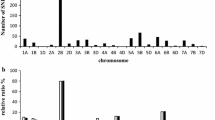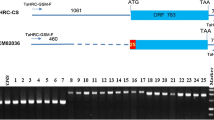Abstract
Key message
Identification of an EST-SSR molecular marker associated with Blister blight, a common fungal disease of tea, facilitating marker-assisted selection, marking a milestone in tea molecular breeding.
Abstract
lister blight (BB) leaf disease of tea, caused by the fungus Exobasidium vexans, results in 25–30% crop loss annually. BB is presently controlled by Cu based fungicides, but genetic resistance is the most viable option in disease management. Tea is a naturally out-crossing, woody perennial necessitating a long time for completion of a breeding programme. Marker-assisted selection (MAS) is vital to expedite breeding programmes and also for better accuracy in gene identification. The aim of the current research was to derive marker-trait associations using an F1 population segregating for BB. The population was genotyped at 11 expressed sequence tag simple sequence repeat loci followed by detecting the alleles by fragment analysis. The genotypic and phenotypic data were subjected to single-marker analysis resulting in the identification of EST-SSR073 as a diagnostic marker amplifying three alleles of the sizes, 168, 170 and 190 bp in F1. Of them, alleles 190 and 168 bp were confirmed to concur BB resistance and susceptibility, respectively. The alleles were validated in a panel of 64 tea cultivars, resulting in the amplification of 12 alleles at EST-SSR073. The EST-SSR073 allele sequences matched with Camellia sinensis photosystem-I reaction center subunit-II. The marker EST-SSR073 can be effectively used in breeding tea against BB, recording a milestone in MAS in tea.


Similar content being viewed by others

Data availability
Provided as supplementary material.
References
Agnihothrudu V, Moulli BC (1991) Blister blight of tea, its control and future lines of research. In: Proceedings of International Symposium on Tea Science, August 26–29, Shizuoka, Japan, pp. 655–659.
Agrios G (1997) Plant pathology, 4th edn. Academic Press, San Diego, CA, p 635
Anon (2002) T.R.I advisory circular PN 1. Tea Research Institute of Sri Lanka. https://www.tri.lk/userfiles/file/Advisory_Circulars/TRI_Advisory_Ciculars_PN_01.pdf Accessed on 25 Mar 2020
Anon (2019) Annual ITC Bulletin of Statistics. International Tea Committee. pp 50
Baby UI, Balasubramanian S, Ajay D, Premkumar R (2004) Effect of ergosterol biosynthesis inhibitors on blister blight disease, the tea plant and quality of made tea. Crop Prot 23:795–800
Barooahi AK, Kalita N, Borthakur MN, Barooaht A, Barman T (2012) Non-tariff trade barriers—pesticide residues and heavy metals in tea and approaches to mitigate them. Two Bud 59(2):1–8
Chang Y, Oh EU, Lee MS et al (2017) Construction of a genetic linkage map based on RAPD, AFLP, and SSR markers for tea plant (Camellia sinensis). Euphytica. https://doi.org/10.1007/s10681-017-1979-0
Chen L, Gao Q-K, Chen D-M, Xu C-J (2005) The use of RAPD markers for detecting genetic diversity, relationship and molecular identification of Chinese elite tea genetic resources [Camellia sinensis (L.) O. Kuntze] preserved in a tea germplasm repository. Biodivers Conserv 14:1433–1444. https://doi.org/10.1007/s10531-004-9787-y
Kafkas S, Ercişli S, Doğan Y et al (2009) Polymorphism and genetic relationships among tea genotypes from Turkey revealed by amplified fragment length polymorphism markers. J Am Soc Hortic Sci 134:428–434. https://doi.org/10.21273/jashs.134.4.428
Karunarathna KHT, Mewan KM, Weerasena OVDSJ, Perera SACN, Edirisinghe ENU, Jayasoma AA (2018) Understanding the genetic relationships and breeding patterns of Sri Lankan tea cultivars with genomic and EST-SSR markers. Sci Hortic 240:72–80. https://doi.org/10.1016/j.scienta.2018.05.051
Lee KJ, Lee JR, Sebastin R et al (2019) Assessment of genetic diversity of tea germplasm for its management and sustainable use in Korea genebank. Forests 10:780. https://doi.org/10.3390/f10090780
Leung LK, Su Y, Chen R, Zhang Z, Huang Y, Chen ZY (2001) Theaflavins in black tea and catechins in green tea are equally effective antioxidants. J Nutr 131(9):2248–2251
Liyi X, Liqiang T, Liyuan W, Guinian Q, Hao C, Kang W (2016) QTL Analysis for anthracnose resistance in tea plant (Camellia sinensis)[J]. J Tea Sci 36(4):432–439
Ma JQ, Yao MZ, Ma CL, Wang XC, Jin JQ et al (2014) Construction of a SSR-Based genetic map and identification of QTLs for catechins content in tea plant (Camellia sinensis). PLoS ONE 9(3):e93131. https://doi.org/10.1371/journal.pone.0093131
Magoma GN, Wachira FN, Obanda M, Imbuga M, Agong SG (2000) The use of catechins as biochemical marker in diversity studies of tea (Camellia sinensis L.). Genet Resour Crop Evol 47:107–114
Meegahakumbura MK, Wambulwa MC, Thapa KK, Li MM, Möller M, Xu JC et al (2016) Indications for three independent domestication events for the tea plant (Camellia sinensis(L.) O. Kuntze) and new insights into the origin of tea germplasm in China and India revealed by nuclear microsatellites. PLoS ONE 11(5):155369
Mewan KM, Saha MC, Pang Y, Abeysinghe ISB, Dixon RA. (2007) Construction of a genomic and EST simple sequence repeats (SSRs) based genetic linkage map of tea (Camellia sinensis L.). Proceedings of the Second Symposium on Plantation Crop Research; 2007 Oct 16–17; Colombo, Sri Lanka. pp. 97–103.
Punyasiri PAN, Abeysinghe ISB, Kumar V (2005) Preformed and induced chemical resistance of tea leaf against Exobasidium vexans infection. J Chem Ecol 31:1315–1324
Singh ID, Chakraborty S, Neog N (1996) Genetic variability and G x E interaction for yield components in seed and clonal cultivars of tea (Camellia sinensis L.). Indian J Genet Plant Breed 56:323–328
Sinniah GD, Alagiyawadu U and Wasantha KL (2012) An assessment key for tea blister blight: development and validation. Proceedings of 4th Symposium on Plantation Crop Research. pp. 135–144 .Sep 20–21. Taj Samudra Hotel, Colombo, Sri Lanka.
Tan L, Wang L, Xu L et al (2016) SSR-based genetic mapping and QTL analysis for timing of spring bud flush, young shoot color, and mature leaf size in tea plant (Camellia sinensis). Tree Genet Genomes 12:52. https://doi.org/10.1007/s11295-016-1008-9
Taniguchi F, Furukawa K, Ota-Metoku S et al (2012) Construction of a high-density reference linkage map of tea (Camellia sinensis). Breed Sci 62:263–273. https://doi.org/10.1270/jsbbs.62.263
Trifonov EN (2003) Tuning function of tandemly repeating sequences: a molecular device for fast adaptation. In: Wasser SP (ed) Evolutionary theory and processes: nodern horizons, papers in honor of Eviatar Nevo. Kluwer Academic Publishers, Amsterdam, The Netherlands, pp 1–24
Wambulwa MC, Meegahakumbura MK, Kamunya S, Muchugi A, Moller M, Liu J et al (2016) Insights into the genetic relationships and breeding patterns of the African tea germplasm based on nSSR markers and cpDNA sequences. Front Plant Sci 7:1244
Wang RJ, Gao XF, Kong XR, Yang J (2016) An efficient identification strategy of clonal tea cultivars using long-core motif SSR markers. Springer Plus. https://doi.org/10.1186/s40064-016-2835-8
Xu LY, Wang LY, Wei K et al (2018) High-density SNP linkage map construction and QTL mapping for flavonoid-related traits in a tea plant (Camellia sinensis) using 2b-RAD sequencing. BMC Genomics. https://doi.org/10.1186/s12864-018-5291-8
Zhang Y, Zhang X, Chen X et al (2018) Genetic diversity and structure of tea plant in Qinba area in China by three types of molecular markers. Hereditas. https://doi.org/10.1186/s41065-018-0058-4
Zhao DW, Yang JB, Yang SX et al (2014) Genetic diversity and domestication origin of tea plant Camellia taliensis (Theaceae) as revealed by microsatellite markers. BMC Plant Biol 14:14. https://doi.org/10.1186/1471-2229-14-14
Acknowledgements
The authors acknowledge the financial assistance from the National Research Council, Sri Lanka under the research grant NRC 09-066.
Funding
Financial assistance from the National Research Council, Sri Lanka under the research grant NRC 09-066.
Author information
Authors and Affiliations
Contributions
KHTK and KMM conceived and designed the experiments. SACNP and KHTK analyzed the data. KHTK, KMM, OVDSJW and ENUE performed the experiments. KHTK wrote the manuscript, SACNP reviewed and revised the manuscript. KMM, OVDSJW and SACNP supervised and validated the data. All authors read and approved the manuscript.
Corresponding author
Ethics declarations
Conflict of interest
The authors declare that they have no conflict of interest.
Additional information
Communicated by Howard S. Judelson.
Publisher's Note
Springer Nature remains neutral with regard to jurisdictional claims in published maps and institutional affiliations.
Electronic supplementary material
Below is the link to the electronic supplementary material.
Rights and permissions
About this article
Cite this article
Karunarathna, K.H.T., Mewan, K.M., Weerasena, O.V.D.S.J. et al. A functional molecular marker for detecting blister blight disease resistance in tea (Camellia sinensis L.). Plant Cell Rep 40, 351–359 (2021). https://doi.org/10.1007/s00299-020-02637-6
Received:
Accepted:
Published:
Issue Date:
DOI: https://doi.org/10.1007/s00299-020-02637-6



